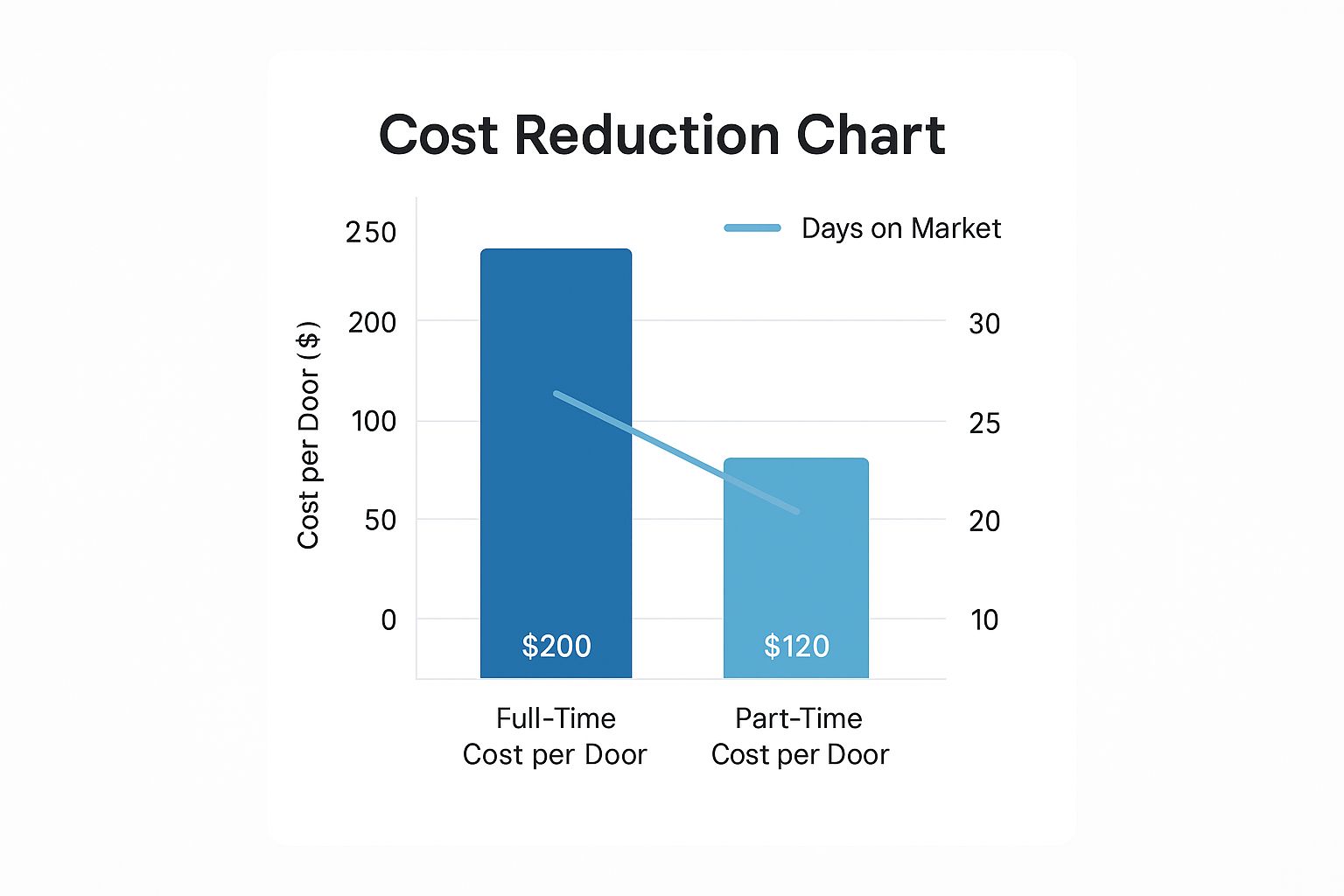For large-scale property management companies, every vacant day is a direct hit to the P&L. A part time leasing agent strategy is your on-demand solution to showing properties at scale, converting qualified leads into signed leases, and slashing vacancy costs—all without the fixed overhead of a full-time hire. For operations leaders managing distributed portfolios, this model isn't just a convenience—it's a core operational framework for reducing Days on Market (DOM) and optimizing cost-per-door.
The Modern Challenge of Scaling Leasing Operations

If you're overseeing hundreds—or even thousands—of single-family homes or multifamily units without onsite staff, you know the struggle. How do you keep your lead-to-tour conversion rates high and your vacancy rates low without your payroll spiraling out of control? Every day a property sits empty is a direct hit to your bottom line.
The traditional model—relying on full-time, salaried leasing agents—simply breaks down at scale. It creates scheduling nightmares, agent windshield time across dispersed portfolios, and critical bottlenecks that delay showings. Those delays are revenue killers. A qualified lead who can't secure a same-day showing will move on to the next property on their list, often within hours.
This friction is what sends your Days on Market (DOM) through the roof. For a portfolio of 1,000 units with an average rent of $1,800/month, just one extra day of vacancy per property costs your portfolio $60,000 in lost revenue. The financial impact is immediate and significant.
Shifting from a Fixed Cost to a Variable Solution
Hiring part-time leasing agents fundamentally reframes your cost structure. Instead of treating leasing as a fixed overhead expense, you turn it into a flexible, results-driven operational cost. This isn't a temporary band-aid; it's a critical component of a lean, scalable property management operation.
By tapping into a network of on-demand agents, you can immediately:
- Offer Same-Day Showings: When a lead comes in, you can schedule a tour within hours, capturing prospects at peak interest.
- Slash Your Cost-Per-Door: You only pay for productive, revenue-generating activities like completed showings. No more paying for agent downtime or travel between appointments.
- Boost Your Lead-to-Tour Conversion Rate: Instant availability and rapid responses directly translate to more completed tours and more signed leases.
This approach transforms leasing from a logistical bottleneck into a scalable, efficient machine for growth. It directly targets the KPIs that matter most—DOM, cost per door, and lead conversion—to maximize returns across your entire portfolio.
So, What Exactly Is a Part-Time Leasing Agent?

In a modern, tech-enabled leasing operation, a part-time leasing agent is a strategic asset. Think of them less as a temporary hire and more as the essential human touchpoint that converts a high-intent digital lead into a signed lease, accelerating your speed-to-lease cycle.
Their primary function is to eliminate the friction between online interest and an in-person tour, which is the biggest drop-off point in the leasing funnel. By closing this gap—fast—they directly impact revenue and free up your core team to focus on portfolio growth and owner relations.
For property management companies managing large, geographically dispersed portfolios, the part-time agent is a force multiplier. They are the key to offering same-day showings across an entire market, a massive competitive advantage that slashes your Days on Market (DOM) and minimizes vacancy loss.
This isn't a niche strategy; it's a proven model for scalable growth. Industry data shows that 33% of all leasing agents are hired by firms managing between 100 to 500 units—a clear indicator of its effectiveness in growing portfolios. You can dive deeper into the leasing agent demographics to see the full breakdown.
What Do They Actually Do?
Don't let the "part-time" title fool you; their impact is full-scale. When integrated into an automated system, these agents handle the high-leverage tasks that keep your leasing engine running at peak efficiency.
Their duties are laser-focused on moving prospects from "interested" to "application submitted":
- On-Demand Property Showings: Their core function is to provide immediate, professional in-person tours for qualified leads, ensuring every prospect receives a consistent, branded experience.
- Prospect Follow-Up: Post-tour, they gather critical feedback, answer property-specific questions, and gauge renter interest—valuable data that flows directly back to your in-house team.
- Application Assistance: They are trained to guide interested renters through the initial application steps, ensuring accuracy and preventing process delays.
The Agent as a Revenue Driver
Ultimately, the value of a part-time leasing agent is measured by their direct impact on your NOI. Every tour they conduct is an opportunity to secure a lease that might have otherwise been lost to a competitor due to scheduling delays.
By specializing in this critical, mid-funnel stage, they ensure your leasing pipeline remains fluid, allowing your full-time staff to focus on higher-level strategy: nurturing owner relationships, optimizing marketing spend, and expanding the portfolio.
Calculating the Financial Impact on Your Portfolio
For any operations-focused leader, the decision to adopt a new staffing model comes down to the numbers. Shifting from a traditional, fixed-cost leasing team to a flexible, on-demand model isn’t just a small tweak—it’s a fundamental change from paying for time to paying for results.
A full-time leasing agent carries a significant fixed cost: salary, benefits, payroll taxes, training, and equipment. The real hidden cost, however, is unproductive downtime—hours spent waiting for leads or driving between scattered properties. This fully-loaded cost inflates your cost-per-showing and, ultimately, your cost-per-lease.
In contrast, an on-demand part-time agent model operates on variable costs. You only pay for specific, revenue-generating activities, like a completed showing. This eliminates the financial drain of downtime and directly ties every dollar spent to an action that gets your property leased faster.
Comparing Staffing Models Head-to-Head
To quantify the difference, let’s compare the two approaches. The pay for a part-time leasing agent naturally fluctuates based on the market. For instance, in Las Vegas, the average hourly wage is around $17.70. This flexible structure is far more efficient than a fixed salary, especially when leasing demand ebbs and flows.
With a flexible model, you convert a fixed operational expense into a variable one that scales perfectly with your leasing velocity. This move directly boosts your cost-per-door efficiency and protects profit margins during slower seasons.
The infographic below highlights the financial and operational advantages, comparing the cost-per-door of a full-timer against the on-demand model and showing the direct impact on Days on Market.

As illustrated, the part-time model not only lowers direct costs but also accelerates leasing velocity, reducing vacancy loss and increasing revenue.
The Real ROI: Reducing Days on Market
The single most powerful financial lever in property management is reducing Days on Market (DOM). Every day a unit sits empty is lost revenue you can never recover. A network of part-time leasing agents is a game-changer here, as their ability to offer same-day showings is the key to slashing DOM.
Let's run a simple ROI calculation for a large portfolio:
- Portfolio Size: 1,000 units
- Average Rent: $1,800/month (or $60/day)
- DOM Reduction: 5 days per vacancy
If you cut DOM by just five days for each unit that turns over, you recover $300 in lost rent per lease. Assuming a 30% annual turnover rate (300 units), that five-day reduction translates to $90,000 in additional annual revenue.
This direct financial gain often far exceeds the cost of an on-demand showing service. The connection between how showing availability impacts vacancy rate is undeniable, making the business case for this operational shift crystal clear.
How to Hire and Manage a High-Performing Team
Building a team of part-time leasing agents requires a different operational playbook than hiring a single full-time employee. Success isn't about finding one unicorn candidate; it's about creating a scalable, repeatable system that produces high-performing agents who act as a true extension of your brand.
The objective is to deliver a standardized, professional experience for every prospect, ensuring each tour effectively moves a lead closer to submitting an application.
This begins with a well-defined hiring profile. Look beyond basic real estate knowledge. You need agents who are tech-savvy, reliable, and possess exceptional communication skills. They must be comfortable using mobile apps for scheduling, submitting feedback reports, and accessing property details on the fly.
Identifying the Right Candidates
When screening applicants for a part-time role, prioritize operational skills and reliability. You're looking for proactive problem-solvers. Can they think on their feet when a prospect asks a challenging question? Are they punctual and responsive? These are the traits that ensure a smooth, high-quality showing experience.
A well-crafted job description is your first filter. To attract top talent efficiently, explore strategies to streamline your recruitment process that help you identify these key traits. For a great starting point, check out our detailed leasing agent job description to build out your own.
Building a Scalable Management System
Managing a distributed team of agents with spreadsheets and phone calls is a recipe for operational failure. That manual approach breaks down quickly, leading to missed tours and an inconsistent prospect experience. A scalable system is built on three pillars:
- Standardized Digital Training: Develop on-demand training modules covering your brand standards, fair housing compliance, and key property selling points. This ensures every agent delivers a consistent message.
- Centralized Communication Protocol: Use a single platform for all communications to eliminate scattered texts and emails. This prevents information loss and keeps the entire team aligned.
- Performance Tracking Dashboards: Leverage technology to monitor key performance indicators (KPIs) like showing completion rates, prospect feedback scores, and agent acceptance speed.
The guiding principle is to systemize everything. A repeatable process for hiring, training, and managing agents eliminates operational bottlenecks, allowing you to maintain quality control across hundreds of monthly showings without increasing management overhead. This directly boosts lead-to-tour conversion rates and shrinks your days on market.
Using Technology to Optimize Agent Performance
Hiring a team of part-time leasing agents is the first step. The second, more critical step is leveraging technology to transform that group of individuals into a coordinated, high-performance leasing machine.
Without a robust platform, you face a logistical nightmare of spreadsheets, group texts, and missed revenue opportunities that is impossible to manage at scale.
Modern PropTech platforms serve as the central nervous system for an on-demand agent network. They automate the tedious, time-consuming tasks that would otherwise overwhelm your core team, enabling you to manage a large field force with minimal effort.

A centralized dashboard like this provides a real-time, 30,000-foot view of your entire leasing funnel, from lead capture to tour completion.
Key Automation Features for Scalability
To successfully implement a part-time agent strategy, your technology stack must excel at three core functions. These aren't just "nice-to-haves"—they are essential for reducing manual work, converting leads at a higher rate, and gathering the data needed for continuous optimization.
Your platform must have:
- Automated Scheduling and Routing: When a prospect requests a showing, the system should instantly match them with the best-qualified local agent based on proximity, availability, and performance score. This eliminates manual dispatching.
- Centralized Communication Hub: All agent communications, property access details, and showing instructions must live within a single, unified platform to ensure consistency and prevent errors.
- Performance Analytics: The platform must provide dashboards to track key metrics like showing completion rates, agent response times, and prospect feedback. This is how you maintain quality control across a remote workforce.
This level of automation directly impacts your bottom line by ensuring every lead receives a fast, professional response. As you explore AI automation for businesses, you'll see how this technology empowers agents to focus on what matters: building rapport and leasing homes.
Seamless Integration and Data Flow
For large-scale property management companies, standalone tools create data silos and operational friction. Your showing automation platform must integrate seamlessly with your core Property Management Software (PMS).
This API integration creates a frictionless flow of information. Leads from marketing channels are automatically pushed into the showing platform, and all tour data and feedback sync back to your PMS in real-time. This eliminates manual data entry and provides a single source of truth.
This type of connected ecosystem is crucial as the property management market continues to expand. Projections show it growing from USD 26.49 billion in 2024 to USD 42.78 billion by 2030, a boom driven almost entirely by cloud-based technologies.
By creating a unified system, you can effectively optimize your leasing funnel and ensure no lead falls through the cracks.
Still Have Questions?
Transitioning to an on-demand leasing model is a significant operational shift, especially when managing a large, distributed portfolio. It’s natural for operations directors and portfolio managers to have questions. Here are the most common ones we address.
How Do You Keep Showings On-Brand With Part-Time Agents?
The answer is robust systems, not micromanagement. A strong operational framework is key to maintaining brand consistency.
This framework includes a standardized digital training playbook covering your company’s value proposition, property-specific instructions delivered via a mobile app, and a consistent feedback loop. A platform that captures post-tour prospect surveys and agent performance ratings provides all the quality control necessary. This data-driven approach ensures every prospect receives a professional, on-brand experience, regardless of who conducts the tour.
What's the Real Impact on Days on Market?
The impact on your Days on Market (DOM) is direct and substantial. An on-demand network enables you to offer same-day showings, capturing high-intent leads the moment they inquire. If your full-time agent is booked, a local part time leasing agent can conduct the tour within hours, not days.
For a large portfolio, shaving just 5-10 days off your average vacancy time per unit generates significant revenue. We're talking tens of thousands of dollars in recovered income across your properties each year. Speed-to-lease is one of the most powerful levers you can pull to maximize rental income.
How Does This Model Plug Into Our Existing Leasing Software?
Modern on-demand showing platforms are built for integration. They use APIs to connect directly with the Property Management Software (PMS) and CRM you already use, such as Appfolio or Rentvine.
This creates a seamless, automated workflow that eliminates manual data entry and provides your central team with full visibility into field operations. Here’s how it works:
- A lead from your website or a listing portal is automatically funneled into the showing platform to book a tour.
- The system intelligently dispatches the best available local agent.
- After the tour, all showing notes and prospect feedback are pushed directly back into your PMS.
It’s a closed-loop system that ensures no lead is ever dropped. Your core software remains the single source of truth, while your cost-per-door and overall operational efficiency see a major boost.
Ready to see how an on-demand agent network can cut your Days on Market and boost your portfolio's revenue? Showdigs combines powerful automation software with a network of vetted, on-demand agents to get your properties leased faster. Learn more and schedule a demo.







